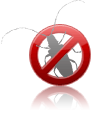Thousand canker disease

- Latin : Geosmithia morbida M. Kolarík, E. Freeland, C. Utley & Tisserat
- English: Thousand canker disease
- French: Maladie des mille chancres
- Order/Class: Hypocreales
Description
Distribution
This species is not found in Canada
Micro-habitat(s)
Bark, phloem
Damage, symptoms and biology
Thousand canker disease is caused by two pests acting together: a fungus in the genus Geosmithia and an insect called the walnut twig beetle (Pityophthorus juglandis).
The minute (about 1.5 mm-long) dark brown beetle excavates numerous galleries in the inner bark layer, or phloem. This network of galleries blocks the flow of phloem sap, depriving the tree of nutrients required for its growth. As walnut twig beetles excavate tunnels, they introduce the fungus, which leads to the development of multiple fungal cankers or necrotic areas under the bark that accelerate the tree’s decline. The wood around these galleries becomes discoloured. Trees may die quickly, often within a year after the first symptoms appear. The symptoms are similar to those associated with drought: leaves turn yellow and wilt and subsequently turn brown. They may remain attached to the branch even after it dies. Dieback always appears to start in the upper crown and progress to lower branches. Given their size, the insects are difficult to locate, and the entrance holes, which are just as miniscule, can only be seen with a magnifying glass. Pityophthorus juglandis is very prolific and it has been estimated that a generation of insects can be produced during an interval of just 2 months. Other insects could potentially transmit the disease in Eastern North America: Xylosandrus germanus, Xyleborinus saxesenii, Xyleborus ferrugineus, Pityophthorus lautus, Hypothenemus eruditus.
A second type of canker caused by a different fungus, Fusarium solani, may occur on the trunk of affected trees.
Comments
In its native range (Arizona, California, New Mexico), Pityophthorus juglandis is associated with another walnut species, the Arizona walnut (Juglans major); however, it does not cause enough damage to kill affected trees and damage is limited to small-diameter branches. On black walnuts, the insect is much more aggressive. Instead of the twigs, it attacks the trunk and branches greater than 2 cm. The beetle’s association with the fungus Geosmithia morbida greatly increases its impact, and thousand canker disease has been linked to die-offs of black walnut.
Researchers and monitoring agencies are concerned about thousand canker disease for several reasons. The insect-fungus association can kill a large black walnut tree in less than a year. Affected trees are generally doomed since the appearance of symptoms means that the tree is already heavily infested. Black walnut is a high value tree that is already in trouble in some regions of North America. Furthermore, this species indigenous to North America is planted all over the world, particularly in Europe, because it is prized for its wood, its fruit and its aesthetic value.
There are not many effective control measures for this hard to detect disease. Infected trees will die and must be removed as they favour the propagation of the fungus and the vector insect. Mechanical control of the disease is effective for small isolated walnut populations. Controlling the vector could be an option. However, the efficacy of insecticides on this beetle is not well known.
The insect-disease complex could be propagated by humans transporting firewood, wood packaging materials and pallets, lumber and veneer commodities, horticultural and/or nursery commodities (seedlings and scions).
References
City of Boulder, Colorado. 2008. Insect and Disease – Thousand canker disease. http://www.bouldercolorado.gov/index.php?option=com_content&task=view&id=7793&Itemid=3157#black%20walnut. Consulté le 11 décembre 2008.
City of Boulder, Colorado. 2008. Thousand canker disease – Frequently Asked Questions. http://www.bouldercolorado.gov/index.php?option=com_content&task=view&id=7801&Itemid=3157. Consulté le 11 décembre 2008.
Clark, B. 2008. Fungus New to Washington is Killing Walnut Trees. CAHNRS and WSU Extension Marketing and News, Washington State University. http://cahnrsnews.wsu.edu/reportertools/news/2008/walnut-canker-2008-11.html. Consulté le 11 décembre 2008.
Colorado State University. Pest Alert. Walnut Twig Beetle and Thousand Cankers Disease of Black Nut. http://wci.colostate.edu/Assets/pdf/WalnutDecline08.pdf. Consulté en janvier 2009.
Cranshaw, W. 2009. Thousand Cankers Disease Management in Urban Forestry. Draft. On line: http://www.coloradotrees.org/News/Thousand%20Cankers%20Disease%209-09.pdf. Consulté le 14 décembre 2011.
Farr, D.F.; Rossman, A.Y. [N.D.]. Fungal Databases, Systematic Mycology and Microbiology Laboratory, ARS, USDA. http://nt.ars-grin.gov/fungaldatabases/. Consulté le 14 décembre 2011.
Garvey, K.K. 2010. Thousand Cankers Disease Spreading; Now in East Tennessee. Univ. California, Davis, Department of Entomology, http://entomology.ucdavis.edu/news/thousandcankersdiseasespreading.html. Consulté le 2 septembre 2010.
Klimaszewski, J.; Langor, D.W.; Majka, C.G.; Bouchard, P.; Bousquet, Y.; LeSage, L.; Smetana, A.; Sylvestre, P.; Pelletier, G.; Davies, A.; DesRochers, P.; Goulet, H.; Webster, R.P.; Sweeney, J.D. 2010. Review of adventive species of Coleoptera (Insecta) recorded from eastern Canada. Pensoft Publishers, Sofia, Bulgaria. 272 pp.
Kolarík, M.; Freeland, E.; Utley, C.; Tisserat, N. 2011. Geosmithia morbida sp. nov., a new phytopathogenic species living in symbiosis with the walnut twig beetle (Pityophthorus juglandis) on Juglans in USA. Mycologia 103:325-332.
Newton, L.; Fowler, G.; Neeley, A.; Schall, R.; Takeuchi, Y. 2009. Pathway Assessment: Geosmithia sp. and Pityophthorus juglandis Blackman movement from the western into the eastern United States. United States Department of Agriculture, Animal and Plant Health Inspection Service. 50 pp.
North American Plant Protection Organization. 2008. Phytosanitary Alert System. Geosmithia sp. and Pityophthorus juglandis. http://www.pestalert.org/viewNewsAlert.cfm?naid=65. Consulté en janvier 2009.
Pscheidt, J.W. 2008. Walnut -- Black Walnut Decline, in An online Guide to Plant Disease Control, Oregon State University Extension, http://plant-disease.ippc.orst.edu/factsheet.cfm?RecordID=1505&rec_type=disease. Consulté le 11 décembre 2008.
Pscheidt, J.W.; Shaw, D. 2008. Investigation of Black Walnut Decline, 2008. 3 pp. http://www.science.oregonstate.edu/bpp/Plant_Clinic/Fungicidebooklet/2008/BLACK%20WALNUT.pdf. Consulté le 11 décembre 2008.
Tisserat, N.; Cranshaw, W.; Putnam, M.L.; Pscheidt, J.; Leslie, C.A.; Murray, M.; Hoffman, J.; Barkley, Y.; Alexander, K.; Seybold, S. J. 2011. Thousand cankers disease is widespread in black walnut in the western United States. Plant Health Progress, doi:10.1094/PHP-2011-0630-01-BR.